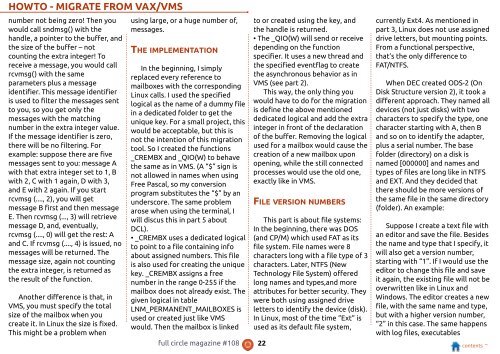Create successful ePaper yourself
Turn your PDF publications into a flip-book with our unique Google optimized e-Paper software.
HOWTO - MIGRATE FROM VAX/VMS<br />
number not being zero! Then you<br />
would call sndmsg() with the<br />
handle, a pointer to the buffer, and<br />
the size of the buffer – not<br />
counting the extra integer! To<br />
receive a message, you would call<br />
rcvmsg() with the same<br />
parameters plus a message<br />
identifier. This message identifier<br />
is used to filter the messages sent<br />
to you, so you get only the<br />
messages with the matching<br />
number in the extra integer value.<br />
If the message identifier is zero,<br />
there will be no filtering. For<br />
example: suppose there are five<br />
messages sent to you: message A<br />
with that extra integer set to 1 , B<br />
with 2, C with 1 again, D with 3,<br />
and E with 2 again. If you start<br />
rcvmsg (...., 2), you will get<br />
message B first and then message<br />
E. Then rcvmsg (..., 3) will retrieve<br />
message D, and, eventually,<br />
rcvmsg (...., 0) will get the rest: A<br />
and C. If rcvmsg (...., 4) is issued, no<br />
messages will be returned. The<br />
message size, again not counting<br />
the extra integer, is returned as<br />
the result of the function.<br />
Another difference is that, in<br />
VMS, you must specify the total<br />
size of the mailbox when you<br />
create it. In Linux the size is fixed.<br />
This might be a problem when<br />
using large, or a huge number of,<br />
messages.<br />
THE IMPLEMENTATION<br />
In the beginning, I simply<br />
replaced every reference to<br />
mailboxes with the corresponding<br />
Linux calls. I used the specified<br />
logical as the name of a dummy file<br />
in a dedicated folder to get the<br />
unique key. For a small project, this<br />
would be acceptable, but this is<br />
not the intention of this migration<br />
tool. So I created the functions<br />
_CREMBX and _QIO(W) to behave<br />
the same as in VMS. (A “$” sign is<br />
not allowed in names when using<br />
Free Pascal, so my conversion<br />
program substitutes the “$” by an<br />
underscore. The same problem<br />
arose when using the terminal, I<br />
will discus this in part 5 about<br />
DCL).<br />
• _CREMBX uses a dedicated logical<br />
to point to a file containing info<br />
about assigned numbers. This file<br />
is also used for creating the unique<br />
key. _CREMBX assigns a free<br />
number in the range 0-255 if the<br />
mailbox does not already exist. The<br />
given logical in table<br />
LNM_PERMANENT_MAILBOXES is<br />
used or created just like VMS<br />
would. Then the mailbox is linked<br />
to or created using the key, and<br />
the handle is returned.<br />
• The _QIO(W) will send or receive<br />
depending on the function<br />
specifier. It uses a new thread and<br />
the specified eventflag to create<br />
the asynchronous behavior as in<br />
VMS (see part 2).<br />
This way, the only thing you<br />
would have to do for the migration<br />
is define the above mentioned<br />
dedicated logical and add the extra<br />
integer in front of the declaration<br />
of the buffer. Removing the logical<br />
used for a mailbox would cause the<br />
creation of a new mailbox upon<br />
opening, while the still connected<br />
processes would use the old one,<br />
exactly like in VMS.<br />
FILE VERSION NUMBERS<br />
This part is about file systems:<br />
In the beginning, there was DOS<br />
(and CP/M) which used FAT as its<br />
file system. File names were 8<br />
characters long with a file type of 3<br />
characters. Later, NTFS (New<br />
Technology File System) offered<br />
long names and types,and more<br />
attributes for better security. They<br />
were both using assigned drive<br />
letters to identify the device (disk).<br />
In Linux, most of the time “Ext” is<br />
used as its default file system,<br />
currently Ext4. As mentioned in<br />
part 3, Linux does not use assigned<br />
drive letters, but mounting points.<br />
From a functional perspective,<br />
that’s the only difference to<br />
FAT/NTFS.<br />
When DEC created ODS-2 (On<br />
Disk Structure version 2), it took a<br />
different approach. They named all<br />
devices (not just disks) with two<br />
characters to specify the type, one<br />
character starting with A, then B<br />
and so on to identify the adapter,<br />
plus a serial number. The base<br />
folder (directory) on a disk is<br />
named [000000] and names and<br />
types of files are long like in NTFS<br />
and EXT. And they decided that<br />
there should be more versions of<br />
the same file in the same directory<br />
(folder). An example:<br />
Suppose I create a text file with<br />
an editor and save the file. Besides<br />
the name and type that I specify, it<br />
will also get a version number,<br />
starting with “1 ”. If I would use the<br />
editor to change this file and save<br />
it again, the existing file will not be<br />
overwritten like in Linux and<br />
Windows. The editor creates a new<br />
file, with the same name and type,<br />
but with a higher version number,<br />
“2” in this case. The same happens<br />
with log files, executables<br />
full circle magazine #1 08 22 contents ^




